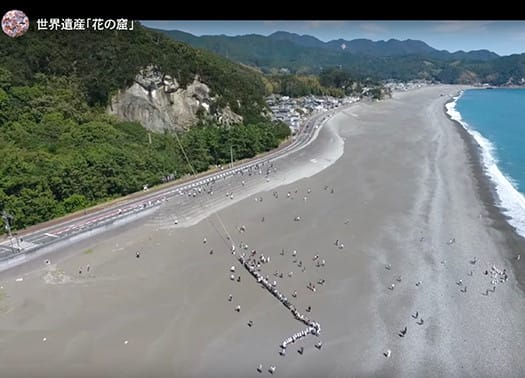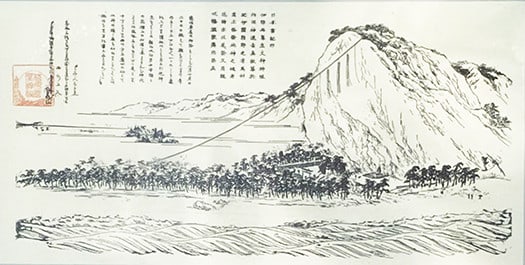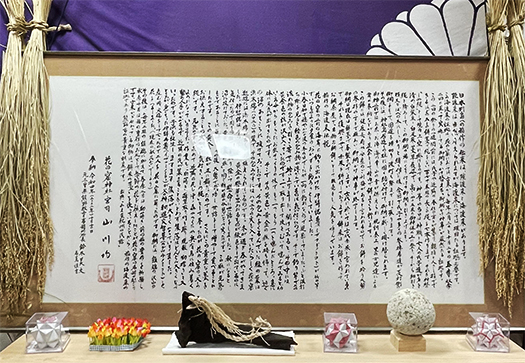


上の図は江戸期のものと思われる木版画。熊野の旅では熊野三山が象徴的なスポットとされているけれど、本宮の祭神はイザナギ・イザナミ夫婦の御子であるスサノオであり、この花の窟神社はその母親であるイザナミを祀っているワケで、いわば熊野信仰の「根源」という位置にこの地域はなるのではないか。
そしてきのうも触れた「縄文から弥生」への転換点としての神話がここには残っているのだという。以下、神社の宮司・山川均氏の署名の文章。出典は「みえ東紀州の民話」という注記。
〜●稲作の海渡来伝説
花の窟の前の海岸に釣りに出掛けたイザナギ尊が竹の竿でいつものように夕食のおかずを釣ろうとしていました。
小春日和で穏やかな波の冬の日でしたが一向に釣れないので、退屈していました。ふと波打ち際を見ると、緑色の包みものが浮かんでいるのに気がついたのです。そこで釣り竿でその流れものの包みを引き寄せて拾い上げました。開けてみるとその中には黄金色の粒がたくさん入っていたのです。ひとつ取りだして皮を剥いて噛んでみると幼い頃、母からもらったお乳そっくりの味で、もうひとつもうひとつと噛んだところ、急に体に元気が出てきたのです。
そこでそのその黄色い黄金の粒を持ち帰って近くの沼のあちこちに投げておいたのです。その包みをくるんでいた緑の葉は浜木綿(ハマユウ)の葉で、その包みの中にはハマユウの実も入っていたらしく、花の窟周辺には浜木綿がたくさん植えられているのです。
冬が過ぎ春がやってきました。イザナギが沼のあたりを見てみると、黄金の粒芽と思われるものが緑色をして出ているのに気付いたので、回りの雑草などをすっかり取り除いて懸命に世話をしました。秋になると、沼に投げておいた黄金色の粒と同じつぶつぶが実っていたのです。,この粒が元気の源であることに気付いて、その後、大勢で栽培し世話をして増やして食べることにしたのです。
この黄金色の粒がまさに稲だったのです。
さらにこの貴重な稲の藁をお供えすることの大切さに気付き、「しめ縄」として奉ったのが花の窟の大しめ縄です。
元気のタネを求めて、近隣の民もこの地に多く住み着くようになっていきました。作業も「籾まき、雑草取り、刈り取り、脱穀、籾摺り」と大勢の人手がかかるので、近隣の民が集まることをいとわず、集落はどんどんと大きくなっていったのです。子どもも誕生して集落はますます大きくなっていきました。〜引用以上。

こういった説話に出会うのはわたし自身はまったくはじめてで、深く驚かされる。
「夕食として魚の採集を考えた」というのはまさに縄文の暮らし方だろうし、はじめて列島人がコメに出会ったときの「急に体が元気になった」というような記述。そしてそれが、集団労働を必須条件としてやがて「集落・ムラ」という社会組織構造を生起していくながれが、明瞭に描かれている。八咫烏もやがて列島人と共生を始める・・・。
そしてその主役としてイザナギ・イザナミが描かれている。国生み・神代というものが米作の伝来と一体として表現されていることになる。浦島太郎伝承以上に非常にわかりやすく重要な「民話」ではないだろうか。
English version⬇
Izanagi and the Cave of Flowers, Tale of the Origin of Rice Cultivation: Imperial Mythology and a Journey to Kumano - 22
Izanagi appeared in the tale of the introduction of rice to the archipelago. A folk tale of rice cultivation that developed on the beach of Hana no Kutsu in the divine era. Is this the root of the belief in the three mountains of Kumano? Kumano Sanzan
The above illustration is a woodblock print believed to be from the Edo period. The main shrine is dedicated to Susanoo, the son of Izanagi and Izanami, and the Hana-no-Kutsu Shrine is dedicated to Izanami, the mother of the main shrine.
The myth of the transition from the Jomon to the Yayoi period, which I mentioned yesterday, is said to have been preserved here. The following is a text signed by Hitoshi Yamakawa, the chief priest of the shrine. The source is a note titled "Folktales of Mie-Higashi-Kishu.
〜Legend of the arrival of rice farmers to the sea
Izanagi no Mikoto went fishing on the beach in front of Hana-no-Kutsu and was trying to catch his dinner as usual with a bamboo pole.
It was a winter day with mild waves and a mild spring day, but he was bored because he could not catch any fish. Suddenly, I looked at the edge of the waves and noticed a green encrusting object floating in the water. So I used my fishing rod to pull the packet of driftwood and picked it up. When I opened it, I found many golden-colored grains inside. I took one out, peeled it, and chewed it. It tasted just like the milk my mother gave me when I was a child, and as I chewed one more and one more, my body suddenly felt full of energy.
So he took the yellow golden grains home and threw them here and there in the nearby swamp. The green leaves that wrapped the package were leaves of the hamayu plant, and it seems that the package also contained hamayu nuts.
Winter has passed and spring has arrived. Izanagi looked around the swamp and noticed that what appeared to be golden grain sprouts were emerging in a green color, so he removed all the surrounding weeds and took care of them diligently. In the fall, I found that the golden grains had borne fruit identical to the golden grains that I had tossed into the swamp. Realizing that these grains were the source of their energy, they decided to cultivate, care for, increase, and eat them.
These golden grains were the very rice.
They also realized the importance of offering this precious rice straw and dedicated it as a "shimenawa" (sacred straw rope), which is the large shimenawa at Hana-no-kutsu.
In search of seeds of vitality, many people from the surrounding area came to live in this area. The work of sowing rice, weeding, harvesting, threshing, and hulling rice required a lot of manpower, so the community grew and grew. Children were born and the village grew larger and larger. ~Quotations and more.
This is the first time I have encountered such a story, and I am deeply surprised.
The description of the Jomon way of life, "thinking of gathering fish for dinner," and the description of the first time the archipelago people encountered rice, "suddenly their bodies became energetic," are all very interesting. The story clearly depicts how the Jomon people developed a social structure called a "village or hamlet," which was based on collective labor as an indispensable condition. Yatagarasu eventually begins to coexist with humankind.
Izanagi and Izanami are depicted as the main characters. The creation of the nation and the age of the gods are expressed as an integral part of the introduction of rice cultivation. This is an important "folk tale" that is easier to understand than the legend of Urashima Taro.



















